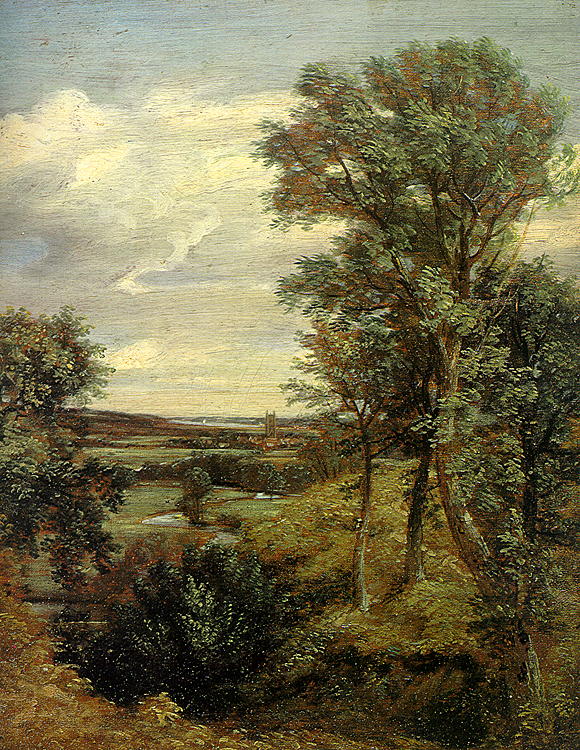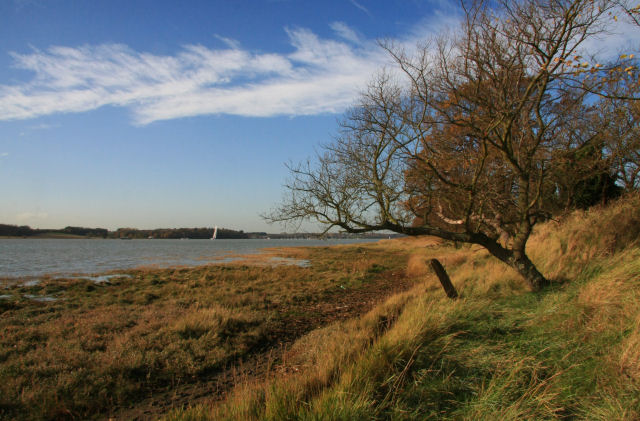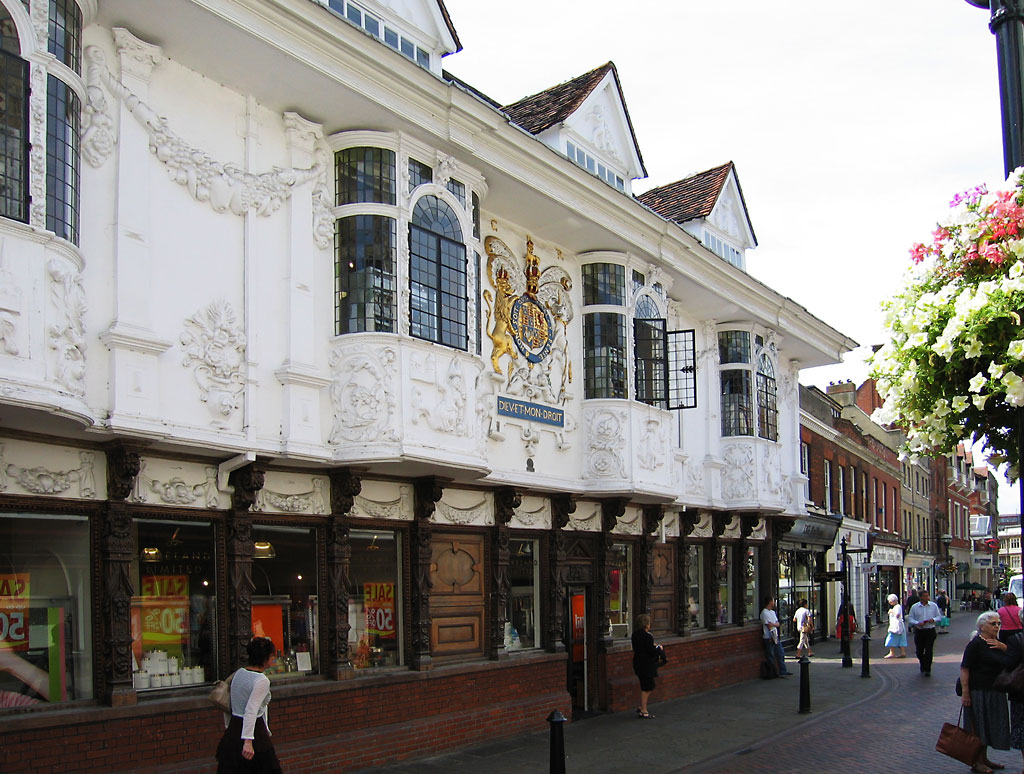|
Freston Causewayed Enclosure
Freston is a Neolithic causewayed enclosure, an archaeological site near the village of Freston in Suffolk, England. Causewayed enclosures were built in England from shortly before 3700 until at least 3500 BC; they are characterised by the full or partial enclosure of an area with ditches that are interrupted by gaps, or causeways. Their purpose is unknown; they may have been settlements, meeting places, or ritual sites. The Freston enclosure was first identified in 1969 from cropmarks in aerial photographs. At it is one of the largest causewayed enclosures in Britain, and would have required thousands of person-days to construct. The cropmarks show an enclosure with two circuits of ditches, and a palisade that ran between the two circuits. There is also evidence of a rectangular structure in the northeastern part of the site, which may be a Neolithic longhouse or an Anglo-Saxon hall. In 2018, a group from McMaster University organized a research project focused on ... [...More Info...] [...Related Items...] OR: [Wikipedia] [Google] [Baidu] |
Suffolk
Suffolk ( ) is a ceremonial county in the East of England and East Anglia. It is bordered by Norfolk to the north, the North Sea to the east, Essex to the south, and Cambridgeshire to the west. Ipswich is the largest settlement and the county town. The county has an area of and a population of 758,556. After Ipswich (144,957) in the south, the largest towns are Lowestoft (73,800) in the north-east and Bury St Edmunds (40,664) in the west. Suffolk contains five Non-metropolitan district, local government districts, which are part of a two-tier non-metropolitan county administered by Suffolk County Council. The Suffolk coastline, which includes parts of the Suffolk & Essex Coast & Heaths National Landscape, is a complex habitat, formed by London Clay and Crag Group, crag underlain by chalk and therefore susceptible to erosion. It contains several deep Estuary, estuaries, including those of the rivers River Blyth, Suffolk, Blyth, River Deben, Deben, River Orwell, Orwell, River S ... [...More Info...] [...Related Items...] OR: [Wikipedia] [Google] [Baidu] |
Scheduled Monument
In the United Kingdom, a scheduled monument is a nationally important archaeological site or historic building, given protection against unauthorised change. The various pieces of legislation that legally protect heritage assets from damage, visual disturbance, and destruction are grouped under the term "Designation (heritage assets), designation". The protection provided to scheduled monuments is given under the Ancient Monuments and Archaeological Areas Act 1979, which is a different law from that used for listed buildings (which fall within the town and country planning system). A heritage asset is a part of the historic environment that is valued because of its historic, archaeological, architectural or artistic interest. Only some of these are judged to be important enough to have extra legal protection through designation. There are about 20,000 scheduled monuments in England representing about 37,000 heritage assets. Of the tens of thousands of scheduled monuments in the UK ... [...More Info...] [...Related Items...] OR: [Wikipedia] [Google] [Baidu] |
Neolithic Longhouse
The Neolithic long house was a long, narrow timber dwelling built by the Old Europeans in Europe beginning at least as early as the period 6000 to 5000 BC. They first appeared in central Europe in connection with the early Neolithic cultures such as the Linear Pottery culture or Cucuteni culture. This type of architecture represents the largest free-standing structure in the world in its era. Long houses are present across numerous regions and time periods in the archaeological record. The long house was a rectangular structure, wide, of variable length, around up to . Outer walls were wattle and daub, sometimes alternating with split logs, with pitched, thatched roofs, supported by rows of poles, three across.The numbers are from Gimbutas (1991) pages 39–41. However, they are approximately the same as the numbers given by other researchers and can therefore be taken as true measurements within a tolerance. The exterior walls would have been quite short beneath the large roo ... [...More Info...] [...Related Items...] OR: [Wikipedia] [Google] [Baidu] |
River Stour, Suffolk
The River Stour (, pronounced rhyming with either "tour" or "sour") is a major river in East Anglia, England. It is long and forms most of the county boundary between Suffolk to the north, and Essex to the south. It rises in eastern Cambridgeshire, passes to the east of Haverhill, Suffolk, Haverhill, through Cavendish, Suffolk, Cavendish, Sudbury, Suffolk, Sudbury, Bures, England, Bures, Nayland, Stratford St Mary and Dedham, Essex, Dedham. It becomes tidal just before Manningtree in Essex and joins the North Sea at Harwich. The origins of its name are unclear, but several possibilities have been proposed by scholars. In 885, the river near Harwich was the site of the Battles of the River Stour. The entire non-tidal river above Manningtree is designated as the Dedham Vale National Landscape, Dedham Vale National Landscape, formerly known as an Area of Outstanding Natural Beauty. It has been painted by a number of prominent artists, including John Constable and Thomas Gains ... [...More Info...] [...Related Items...] OR: [Wikipedia] [Google] [Baidu] |
River Orwell
The River Orwell flows through the county of Suffolk in England from Ipswich to Felixstowe. Above Ipswich, the river is known as the River Gipping, but its name changes to the Orwell at Stoke Bridge, about half a mile below where the river becomes tidal by Bobby Robson Bridge on West End Road. It broadens into an estuary at Ipswich, where the Ipswich dock has operated since the 7th century, and then flows into the North Sea at Felixstowe, the UK's largest container port, after joining the River Stour at Shotley forming Harwich harbour. The large Orwell Bridge carries the A14 trunk road over the estuary to the south of Ipswich. Name In the name ''Orwell'', ''Or-'' comes from an ancient river-name—probably pre-Celtic; but ''-well'' probably indicates an Anglo-Saxon naming. In ''A tour through England and Wales'', written in 1722, Daniel Defoe calls the river "Orwel" (though he does this inconsistently). He also mentions that "a traveller will hardly understand me, especia ... [...More Info...] [...Related Items...] OR: [Wikipedia] [Google] [Baidu] |
East Anglia
East Anglia is an area of the East of England, often defined as including the counties of Norfolk, Suffolk and Cambridgeshire, with parts of Essex sometimes also included. The name derives from the Anglo-Saxon kingdom of the East Angles, a people whose name originated in Anglia (Angeln), in what is now Northern Germany. East Anglia is a predominantly rural region and contains mainly flat or low-lying and agricultural land. The area is known for considerable natural beauty. It shares a long North Sea coastline and contains one of the ten national parks in England, The Broads. Norwich is the largest city in the region. Area Definitions of what constitutes East Anglia vary. The Anglo-Saxon Kingdom of East Anglia, established in the 6th century, originally consisted of the modern counties of Norfolk and Suffolk and expanded west into at least part of Cambridgeshire, typically the northernmost parts known as The Fens. The modern NUTS 2 statistical unit of East Anglia compri ... [...More Info...] [...Related Items...] OR: [Wikipedia] [Google] [Baidu] |
Shotley Peninsula
The Shotley Peninsula is a rural area east of the A137 Ipswich-Colchester road located between the rivers River Stour, Suffolk, Stour and River Orwell, Orwell in Suffolk, England. The peninsula is named after the settlements of Shotley and Shotley Gate which are situated near its south-eastern tip. Other villages on the peninsula include Chelmondiston, Erwarton, Erwarton (Arwarton), Freston, Suffolk, Freston, Harkstead, Holbrook, Suffolk, Holbrook, Stutton, Suffolk, Stutton, Tattingstone, Wherstead and Woolverstone. The population was 10,310 according to the 2001 Census, approximately 12.4% of the total population of Babergh District. Geography The rivers Stour and Orwell meet at Shotley Gate and merge to join with the North Sea in Harwich Harbour. The Stour and Orwell is a designated Special Protection Area, a Site of Special Scientific Interest and a Ramsar Convention, Ramsar site for wetland habitats. The landscape is predominantly ancient estate farmlands, with salt m ... [...More Info...] [...Related Items...] OR: [Wikipedia] [Google] [Baidu] |
Ipswich
Ipswich () is a port town and Borough status in the United Kingdom, borough in Suffolk, England. It is the county town, and largest in Suffolk, followed by Lowestoft and Bury St Edmunds, and the third-largest population centre in East Anglia, after Peterborough and Norwich. It is northeast of London and in 2011 had a population of 144,957. The Ipswich built-up area is the fourth-largest in the East of England and the 42nd-largest in England and Wales. It includes the towns and villages of Kesgrave, Woodbridge, Suffolk, Woodbridge, Bramford and Martlesham Heath. Ipswich was first recorded during the medieval period as ''Gippeswic'', the town has also been recorded as ''Gyppewicus'' and ''Yppswyche''. It has been continuously inhabited since the Anglo-Saxon settlement of Britain, Saxon period, and is believed to be one of the Oldest town in Britain, oldest towns in the United Kingdom.Hills, Catherine"England's Oldest Town" Retrieved 2 August 2015. The settlement was of great eco ... [...More Info...] [...Related Items...] OR: [Wikipedia] [Google] [Baidu] |
Freston Site Map And Cropmarks
Freston may refer to: * Freston, Suffolk, a village south of Ipswich, England * Freston causewayed enclosure, a Neolithic site near the village of Freston * An alternative name for Friston, a village near Saxmundham, Suffolk, England People * Anthony Freston (1757–1819), English Anglican clergyman * Kathy Freston, American self-help author *Tom Freston Thomas E. Freston (born November 22, 1945) is an American media proprietor, businessman, and financier. Early life and education Freston grew up in Rowayton, Connecticut. He received a Bachelor of Arts from Saint Michael's College and an MBA fro ..., American television executive See also * Mission Freston was the code-name of the British Special Operations Executive (SOE) military mission under the command of Col. Capt D.T. Bill Hudson., to German-occupied Poland (1939–1945) during World War II. * Freeston (other) * Frestonia {{disambig, geo, surname ... [...More Info...] [...Related Items...] OR: [Wikipedia] [Google] [Baidu] |
Hambledon Hill
Hambledon Hill is a prehistoric hill fort in Dorset, England, in the Blackmore Vale five miles northwest of Blandford Forum. The hill itself is a chalk outcrop, on the southwestern corner of Cranborne Chase, separated from the Dorset Downs by the River Stour, Dorset, River Stour. It is owned by the National Trust. Prehistory Its earliest occupation was in the Neolithic when a pair of causewayed enclosures were dug at the top of the hill, one smaller than the other. They were linked by a bank and ditch running northwest–southeast. Two long barrows, one in length, also stood within the complex and a third enclosure is now known to underlie later earthworks. In all, the area of activity covered more than . Excavations in the 1970s and 1980s by Roger Mercer produced large quantities of Neolithic material. Environmental analysis indicated the site was occupied whilst the area was still wooded with forest clearances coming later, in the Bronze Age. The charcoal recovered seems to ... [...More Info...] [...Related Items...] OR: [Wikipedia] [Google] [Baidu] |
Crickley Hill
Crickley Hill and Barrow Wake ( & ) is a biological and geological Site of Special Scientific Interest in Gloucestershire, notified in 1974. The site (two parts) lies within the Cotswold Area of Outstanding Natural Beauty. It was formerly known as Crickley Hill and includes some of a site known as Tuffleys Quarry. Part of the site is owned and managed by Gloucestershire Willdlife Trust and the National Trust as a nature reserve Park. The Cotswold Way National Trail passes through Crickley Hill and Barrow Wake. Barrow Wake and Tuffley's Quarry are listed in the 'Cotswold District' Local Plan 2001–2011 (on line) as Key Wildlife Sites. Crickley Hill is listed in the 'Cotswold District' Local Plan 2001–2011 (on line) as an SSSI and Regionally Important Geological Site. Location The site lies south of Cheltenham on the Cotswold scarp and it supports a range of habitats characteristic of the Cotswold limestone. It includes species-rich grassland, semi-natural woodland, sc ... [...More Info...] [...Related Items...] OR: [Wikipedia] [Google] [Baidu] |
Knap Hill
Knap Hill lies on the northern rim of the Vale of Pewsey, in northern Wiltshire, England, about a mile (1.6 km) north of the village of Alton Priors. At the top of the hill is a causewayed enclosure, a form of Neolithic earthwork that was constructed in England from about 3700 BC onwards, characterized by the full or partial enclosure of an area with ditches that are interrupted by gaps, or causeways. Their purpose is not known: they may have been settlements, or meeting places, or ritual sites of some kind. The site has been scheduled as an ancient monument. Knap Hill is notable as the first causewayed enclosure to be excavated and identified. In 1908 and 1909, Benjamin and Maud Cunnington spent two summers investigating the site, and Maud published two reports of their work, noting that there were several gaps in the ditch and bank surrounding the enclosure. In the late 1920s, after the excavation of Windmill Hill and other sites, it became apparent that causewayed enclo ... [...More Info...] [...Related Items...] OR: [Wikipedia] [Google] [Baidu] |








